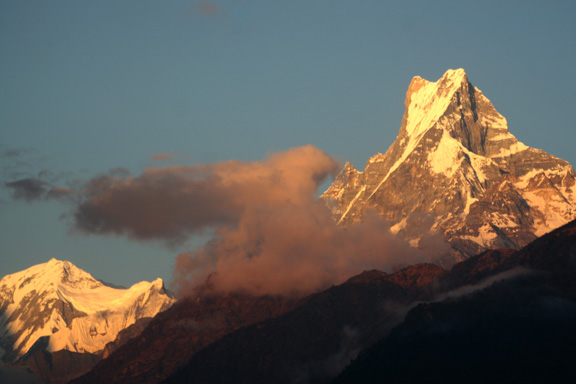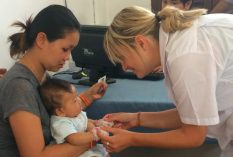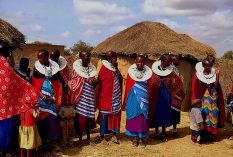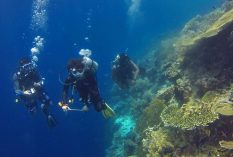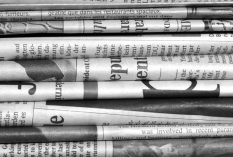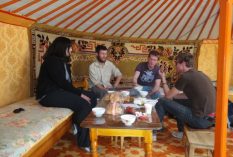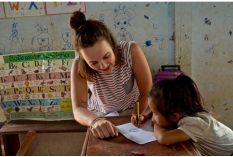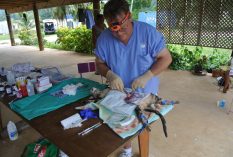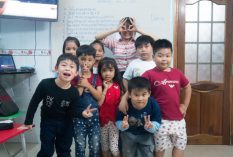Day 1 – 6.11.15
So I’m finally here. Bag-less, but relieved.
My journey started at 4am on Saturday, in order to make it to PDX security by 5:30. By the way, that is way too effing early. Mom made sure I had caffeine and reading materials before giving me one last hug and au revoir. She’s the best. Unfortunately the bohemoth of a security line went really quickly and I had to dump most of my latte in the trash to get through TSA. Since when are they so efficient? For once, it kind of pissed me off.
So I’m through security, re-caffeinated(ish) with a fresh Stumptown latte, and at my gate. Time for a social media post. Except in my flurry of finding adequate coffee and my terminal, I had passed all of the trademark ugly PDX carpet. Daaaaaannnnngggit. Good thing I had to use the restroom, so I picked up everything that I had JUST set down in order to relieve myself/get my insta post on the way back. Shameless.
The order of my flights went like this: PDX>SEA>DXB>KTM
Portland to Seattle was delightfully uneventful, as I listened to the podcast Two Dope Queens in the window seat while the passenger next to me took a snooze.
Seattle to Dubai was a whole different story. I was seated in the middle section, sandwiched in between two large men. My mom foresaw this, and told me I should bat my eyelashes and ask for an aisle. Should have done that. Armrest room? Haaaa. For 13 hours and 47 minutes I hugged myself and watched free movies/pretended to sleep. Shoutout to mom for the anti-anxiety meds, those saved me! By the way, “How to be Single” and “Run” are excellent movies.
The Dubai airport was something else. Everything was duty-free designer and the clocks on the walls were Rolex for crying out loud. I didn’t venture to see the mall, as I wanted to find my terminal first. Turns out that wasn’t a bad idea, because finding the F gates turned into following signs that led to more barren and empty parts of the airport and I soon found myself walking alone after a while. Soon found myself on a bus that transported passengers between terminals that took about 20 minutes to get to Terminal 2 AKA the farthest, smallest, least tricked-out terminal in DXB. By the time I got there, I had no gusto or bravery left to leave and try to see the mall. After exchanging some USD for AED, I got myself a sandwich and a couple bottles of water, then parked it in the lobby to read.
When boarding my last flight to Kathmandu, I ran into some fellow PNWers that had recognized me from the Seattle flight. I had no idea how much some fellow West-Coasters would calm me down and breathe a little easier. Side note: the 102 degree heat in Dubai was always an unpleasant surprise when leaving the terminals to board the bus. And the sky was brown. Just saying. I totally zonked out the entire flight which I was okay with, due to my lack of shut-eye on the SEA>DXB plane.
We arrived around 10:20pm in a drizzle of monsoon rain, but due to the time and the weather I couldn’t see any of my surroundings. Getting my visa was fairly easy, as they have machines that fill out the applications and take your picture for you. Everything was “so far, so good.” Sike. After getting past the immigration officer, I was introduced into a new environment of push versus shove versus “let’s cut this American chick in line because she obviously has no idea what’s happening rn lol.” The so-called security checkpoint was a frenzy of people shoving past each other to get their belongings in the X-Ray and elbowing their way 2 and 3-fold through the metal detector, some having to loop around because of the repeated detector alarm. After I finally made it through, I found my backpack and compression sack sprawled along the floor, the two X-Ray monitors looking after me with utter disinterest, quickly going back to fiddling with their phones as the bags passing through the machine slid across the monitor. Sweet.
Next step was to claim my bag, which I was assured multiple times at each check-in gate would arrive, which I could not do because I was later informed that it was left in Dubai. Forrreeeeaaaal? 5 hours between landing and takeoff and it didn’t make it? Ugh. Thankfully my PNW friends were with me throughout this ordeal for moral and mental support while I struggled with the customs officer to get everything in order. I have to go back tonight in order to claim it. Fingers crossed it’s actually there.
After that ordeal, I exchanged my USD for Rupees and bought a SIM card for my phone. Cool, that worked. As I was finishing up with my phone business, my contact from Green Lion found me, and I think I heard music I was so happy and relieved. And then she said…. “Our car isn’t parked within this parking lot, as there was a bomb threat and security at the airport is so tight that they are not letting passenger cars in. We have to walk to the car, is that okay?”
I’m sorry…. Bomb threat?
So we walk to the car, get in, and proceed down many narrow winding back alleys to arrive “home.” By this time, it’s midnight. The place that I’m staying at is currently under construction, but the food and wifi is at a house down the street, so I can’t complain. Plus, there are bunk beds. All I could say after that was Namaste, and goodnight.
Monday 7.11
We started something called Culture Week, which is like an introductory week where they give us morning classes and afternoon field trips. I met my other culture comrades, all from other countries like Holland, Germany, France, and Egypt. And that’s not even considering the other volunteers already in the house. Classes, meals, and downtime are spent in the “White House,” where Rajesh (Director of Green Lion Nepal) and his family live along with other volunteers in the program. We had ice breakers followed by a combined Buddhist/Hindu greeting ceremony. After that, we were given our Nepali names. Apparently babies are not named until 10 days after their birth, where there is a ceremony and celebration upon the selection. My Nepali name is Kamana, which means “Desire.” Just had to laugh that one off…
In the afternoon session we were given places to find in the area around the neighborhood, ours was “Bashundhara.” Turns out it was the taxi/bus/transit area at the base of the hill of where we were staying, Dhapasi Heights.
After we got back from our little afternoon adventure, we stayed in the White House for down time until dinner. For me, I was waiting until 6:30pm when the airport said my bags would be at the airport for me to pick up. Turns out that Ring Road at 6:30 is rush hour, so it took us an hour to get to the airport that was originally 15 minutes away. The bag exchange was quick and easy, except they didn’t give me the $50 for having me wait a day that Rajesh said that I was entitled to. I was already down a total of 1000 rupees for the round trip to claim my bag. They simply said no, turned around, an ignored me after I got my bag. Kind of a bummer, but I had my stuff.
The drive back also took about an hour, but not for the same rush hour traffic reasoning. Timme and I were dozing off in the back of the cab, when we woke up to a loud noise that accompanied a jolt through the entire cab. There was a van that had come into contact with our front left side, wedging our mirror up against the car in a fashion that made me think it would need a little more than duct tape to fix. The driver immediately got out, started yelling at the other driver, got back in the cab, pulled over on the side of the road, and then they both hopped out and proceeded to argue over the damage to both cars. We sat and waited for 30 minutes at least, continuously being hushed by the driver, until another cab pulled up behind us. Great, we thought. Five more guys hop out and join in the debate. Eventually they put us in the new cab and drove us home, even had me pay full price.
Tuesday 7.12
For Culture Week, we had an ice breaker game of limbo and then started talking about places to go around Kathmandu. Can’t wait to explore all of it! We also had language lessons where we learned how to say our name and where we are from. After lunch, we went to Budhanilkantha (Sleeping Vishnu). We were only able to see it from outside the gates because only Hindus were allowed to approach. It was beautiful.
Wednesday 7.13
In class, we learned about Buddhist and Hindu culture in Nepal, as well as many traditions or customs. This was mostly in the form of a Don’ts list.
Don’t:
Whistle in the house, it draws bad spirits
Use your blanket as a mattress, it brings everyone in the house bad luck
Show the sole of your foot towards someone, it’s rude
Touch someone’s head
Share food, it is considered “Jhuto”
Wear shorts above the knee
Wear tight clothes, transparent fabric, or tank tops
Go bare-chested (men)
Give anything to beggars
Share a room with the opposite sex if you are not married
After lunch, we went to Boudhnath where I led the presentation along with Bishanti and Mohan (Babette and Max from Holland). The stupa was amazing, it was so big and beautiful. However, it was still under construction from the 2015 earthquake so we couldn’t see the very top of it. We explored the side streets of the stupa, where there were many vendors that I was able to buy more presents from.
Thursday 7.14
At 7am we had yoga on the rooftop of the “Green House” because it was raining and we could not do it on the lawn. After yoga we had breakfast and more language lessons, followed by a culinary lesson of sorts. They had us make lunch! We made this kind of fried bread and turmeric potatoes with chili powder, it was really good!
After lunch, they sent us on a scavenger hunt in the market to buy cheap herbs and miscellaneous items. The list of items was in Nepali (of course!) that we needed to buy. I only figured out how to translate a couple items, but they never told me the other items I bought, the shopkeeper just recognized the word and gave them to me.
Friday 7.15
We woke up for an early breakfast so we could go hiking. We walked through the neighborhood and quickly it turned into countryside. We crossed a river and further into the hills where it became more rural. Eventually we stumbled upon another temple and climbed the large hill behind it. I would call it a mountain, but I know better when in the land of the Himalayas. During our climb, we “adopted” a small pack of stray dogs that continued with us until the walk back home. When we were at the top of the hill, there were also hawks that were circling around our heads along with herds of goats below. The Kathmandu Valley was laid out in front of us, clear and sunny.
Monday 7.18
This was our first day at the hospital, and I was a little unsure about was to expect. Previous volunteers had chosen to end their time early within the program, saying that there was not much for them to do or see within the clinic.
The Stupa Community Hospital is in Boudha, which is only about two minute’s walk from the stupa we had visited the week before. Once we pulled up to the hospital, we almost passed it because we didn’t recognize the building as one from the health sector.
The entire hospital is practically open-air, as it has circular levels around an open courtyard. It is about 5-6 stories tall, with each corner dedicated (or sitting vacant) to a different “ward.” Wards are about the size of a large living room and in some cases like the general ward, maybe add on a dining room for size. Stupa only has 55 beds within the facility, and is apparently due for closing down soon due to a newer, larger community hospital’s construction. In Nepal, they have changed their requirements for every hospital to have at least 100 beds.
We were greeted warmly by the head nurse of Stupa; Nila. She gave us a quick run-down before an even quicker tour (due to the small size of the hospital, not because it was not well-explained). There was only one main doctor at the hospital, a GI named Swasti (I have forgotten his last name, it’s about 20 letters long), along with multiple junior doctors completing their residencies that staffed the wards and the ER in the meantime.
As we were looking around, we were shocked if not in awe at the conditions. Which I was expecting, but had no idea what that would really mean in the moment. Doctors and nurses commonly wear flip flops, ALL records are on pen and paper in logbooks, intermittent power outages are deemed commonplace, patients walking in and out of different wards freely (sometimes interrupting doctors with patients, I don’t think they have the same HIPAA standards here….just a hunch), everything warranted sharing a wide-eyed look with my fellow volunteer. This was real.
We were told that this would be mostly observational, which I soon became more than okay with when I realized the amount of TB and other diseases like typhoid and meningitis that were flooding this hospital. No touchy? No prob.
After lunch, we went down to Nila’s office and met other volunteers from other programs. Two of them were also from the US, and a pharmacy student from France. They were nice, and gave us a bit of a heads-up for the rest of our time here. Very laid back hospital, nothing to be too worried about.
Tuesday 7.19
This was our first day with Dr. Swasti, which meant we were in for many an endoscopy. The endoscopy room is a small, unimpressive little setup, but Dr. Swasti can crank them out like no other. But here’s the thing…. They perform endoscopies without any anesthesia, except a local anaesthetic spray for their throat. No thanks! These poor patients are gagging and in pain during the entire procedure, and every one warrants a biopsy. It’s hard to watch. Thankfully he’s quick, each procedure takes about 10 minutes. Between procedures the endoscopy tube sits in a tub of antiseptic and is reused. Also wow.
Wednesday 7.20
We had another day with Dr. Swasti, where we saw many more endoscopies, as well as multiple cases of TB (apparently it can manifest in different places I.e. Lungs, abdomen). Cirrhosis of the liver also seems to be common, due to many people starting to drink in their teens. This causes portal hypertension, and an ability to actually palpate the spleen. Pretty cool party trick, am I right? When Dr. Swasti was making rounds there was a patient who had previously suffered a stroke with an inability to communicate with language, but an intact ability to comprehend. I actually correctly guessed the problem, thanks to my many neuro classes at UO. Broca’s aphasia! I hope my professors would be proud.
Thursday 7.21
Thursday was another day following Dr. Swasti, and also when I started noticing certain oddities in the hospital environment. Doctors take blood pressure recordings over clothing, and usually tend to write 120/80. Every time. Especially with blood pressure, so far every Nepali patient has had a pulse of 70 or 80 bpm. For 60-70 year olds with TB, I’m starting to feel a bit skeptical. Also, pharmaceutical representatives can also come in and make small presentations to doctors about their products, hoping to sell them on the spot. Which apparently happens often.
I saw my first case of typhoid fever as well. It presented as an increased temperature with a decreased pulse. This is abnormal, as usually an increase in body temp warrants an increase in pulse in an attempt to thermoregulate (sweat it out, cool down). The tongue was coated, as well as a palpation investigations that revealed an enlarged liver. Poor guy looked like he was in an immense amount of pain. I felt very thankful for my vaccinations.
Friday 7.22
We were out of the house bright and early (5:45 to give you an idea) in order to get to the hospital by 6:30 in order to observe an open cholecystectomy at 7am. That’s a gallbladder removal by the way. When we stepped into the operating area, we changed into our scrubs and removed our shoes. Normally there are plenty of plastic shower slippers that everyone wears in the actual operating theater, but Vadim and I missed that train, so we went in with socks. Yup, no shoes guys. Open surgery. It happened.
I have seen this type of operation before, but it was done laparoscopically. The incision was about 5 inches long, on her right side below her rib cage. When done with a laparoscopy, it can be done through the belly button. Very different. There were also three surgeons present for the surgery: one to hold the incision open, another to hold up the liver, and a third to tie off and remove the gallbladder. It was a pretty crowded room, with cauterizing tools and no AC. I actually got a bit nauseous and overheated about 3/4 of the way through the surgery, there were too many people in the small, hot room.
The surgeons were open to teaching their way through the surgery, and even opened up the gallbladder to show us the stones inside. He even carried it out to the family who was waiting in the hallway. I repeat… Carried a human organ in a surgical pan in a “sterile” gown out of the OR and into the hallway to show the family. You won’t see that at home.
I feel very lucky to be here, and thankful for the many lessons shared with me. I’m having a hard time putting it into words, but I think my overall feeling after my first week would have to be a combination of humbled and blessed. Humbled by the strength and perseverance of the Nepali people and the medical staff for the conditions in which they live every day, and blessed by the opportunity to come here and learn about the realities of global access to healthcare from the practitioners themselves.
Monday 7.25
There was a strike on Monday in response to the resignation of the Prime Minister of Nepal, which manifested in a Maoist exercise of influence that shut down all public transportation and closing of many businesses, even closing down schools for the day. Rajesh told us that it would be safe to walk to the hospital… Minus the assemblies that may occur in the streets… Or to take a taxi… At the risk of having the cars attacked by protestors… Needless to say Vadim and I opted for staying inside for the day. This turned out to be a fortunate choice, because even the doctors decided not to brave the streets that day.
Tuesday 7.26
Taking the Monday off made for a plenty-busy Tuesday. It turned out that it was also the last day that people could come in to the doctor’s office to get it paid for by their insurance. Let’s just say that chaos ensued.
When we arrived in Dr. Swasti’s office there was already a stack of patient booklets, and people lined up in single file trying to make it into the small room. I was in charge of logging people into the paper register, other volunteers and I trying to create some kind of order within the office, when simultaneously people were barging into the office, interrupting the doctor during a consult. We saw triple the amount of patients that we would normally see in one day.
Oh, and we also saw heroin in the ER. That’s a thing, apparently. There was a woman who came in and couldn’t move her arms without assistance due to her intense body tremors. When the doctor asked her what she had been taking, she said that she would sniff a powder to make herself feel better. It was a blackish-brown powder that she showed the doctor, then snorted. Right there on the table. Another thing that was crazy to me is that they couldn’t take the drug from her because she said she wanted to keep it. She also said that many people in Boudha are taking it. No shit she wanted to keep it, she was an addict going through withdrawals! I died a little on the inside. Vadim and I looked it up to see what it was when we got home, only to find that it was heroin and people gave it the name “brown sugar.”
Wednesday 7.27
This was a fairly slow day, many cases of gastric pain and sinusitis. The most memorable part of the day was the new presence of three second-year medical assistants in training. Trying to seem alert and attentive to whatever Dr. Swasti was doing, only to have it come off as frantic and unorganized. When Swasti gave them a small assignment of labeling which organs were palpable in which quadrants of the abdomen, they turned to Vadim and asked him if the liver was on the left. And whenever Swasti would ask what could be the problem from symptoms presented, they nearly always parroted the previous diagnosis. Needless to say, everyone in the office was a little annoyed.
Thursday 7.28
Pretty exciting day! I feel kind of bad saying that, because it usually means that a patient is experiencing something they wouldn’t have to in the states. Maybe I should say that there were many “learning opportunities” that day. Whatever makes you think I’m not a sadistic jerk works for me. Pinky swear I’m a good person.
In the ER, a woman was admitted in the midst of such a severe allergy attack that she went into anaphylactic shock and they had to perform CPR. Thankfully she was resuscitated, and eventually recovered. The scariest part was that they had no idea what she was allergic to, and that this had happened multiple times before due to her other medical files that her family brought in with her.
We were able to watch a surgery on a TB patient to drain multiple abscesses (pus-filled sacs) within his abdomen. This was a terrifyingly invasive surgery. They went after two different abscesses, and when one popped there was an instantaneous filling of the opening with thick green-yellow liquid coming out of seemingly nowhere. They drained about 500 mL of the greenish goo from his abdomen. The other they were unable to find, and said that it may have popped on its own. After seeing the first one pop, that made me nervous for the patient. This was not the first time he had suffered from TB, and the popping of these abscesses makes it easier for the infection to spread throughout the body and form more painful, infected sacs. There was a third one in his sternum that was visible on an X-Ray, but it was so close to his heart that I think they referred him to another facility. After surgery, he had two incisions accompanying two drains, and another incision on his back. Five holes. Poor guy.
Friday 7.29
Each day in the clinic makes me more thankful for my hygiene and health conditions back in the states. We saw cases of the shingles and mumps mixed in with the many suspected TB and gastritis patients. There was also a woman who was in the midst of a possible paraceteamol overdose because she was experiencing gastric pain and started popping the first pills she could find. Note to everyone experiencing pain: don’t do that.
After Dr. Swasti was finished with patients and his rounds, we waited around until we could observe an anal fistulectomy. If you want to know what that is, I suggest you google it. It’s pretty graphic butt stuff. When we arrived, they had decided to push the fistulectomy back to fit in an appendectomy. Bonus! We got to see both surgeries back-to-back. Very thankful that these surgeons are so willing to teach and humor our many questions.
Monday 8.1
When we arrived at the hospital, we were almost unable to shadow like we had been in the weeks prior due to the large amount of nursing students that had flooded the hospital. In the office of the GI Doctor that we had been shadowing for the last two weeks, there were five alone. Combine that with five volunteers (Me, Vadim, and three others from outside programs) and there was barely room for the doctor and patient. While also considering the fact that no patients come to the hospital without at least two or three supporting family members. When recalling the saying “everyone and their mother…” I am starting to think that whoever coined the phrase first visited Nepal.
We had an earlier lunch due to the low volume of patients, and then had time to kill until a radial ORIF (open reduction internal fixation) at 4pm. Another volunteer and I decided to get some henna on the street outside the hospital (200 rupees for my entire palm and most of my forearm), and then participate in communal volunteer nap time until surgery. Fun fact: the word for nap time in Nepali is “Sutnus.”
I guess that the fifth surgery is the charm, because this finally meant that I was going to get to see an ortho surgery! Commence 30-second dance party… Now back to business.
The patient was a 15 year old male who had seriously messed up his radius (long forearm bone on your thumb side). The bone was cracked fairly cleanly all the way through, and was unfortunately an old fracture. His bone had partly healed, which meant that there was a bone callus that was forming over incorrectly set bones. When they had to re-break the wrist, there were no chisels or high impact materials used. The surgeon was bending his arm back and forth like he was popping a glow stick in order to reduce the fracture. Yikes. The rest of the surgery seemed fairly straightforward, as they re-fixated his radius using a plate and screws. As I had said before, the patients are awake during all surgery, and this kid had to be told to sit still a number of times from his efforts to see what the surgeon was doing. They did not let him see, but we saw him in the ward a couple days later and showed him the pictures because he was still dying of curiosity. Typical teenager!
Tuesday 8.2
This was the shortest day to date, as there were only four patients that came to see Dr. Swasti, and only one case of chronic alcohol liver disease in the ER. By the way, I know a LOT about liver conditions now. Dr. Swasti teaching moment: You have to drink a liter of 80-proof alcohol a day for 10 years in order to cause cirrhosis of the liver. Katya teaching moment: Don’t f***ing do that.
We were out by 11:30am, so we took an early lunch before heading home and taking a nap. Once the other volunteers came back from their project at the school (people come to volunteer teach), few of us went out to Thamel to get souvenirs for our families and ourselves. After wearing ourselves thin while shopping, we rewarded ourselves with dinner in town.
Wednesday 8.3
It was another very slow day at Stupa, with lots of follow up cases from the previous days and weeks, endoscopies, and being driven out by the large number of nursing and medical assistant students that were following some type of swarm behavior around Dr. Swasti. There were also a higher number of power outages this week, I think I counted around three in 45 minutes when I was sitting in Swasti’s office. I am wondering if the higher temperatures make it harder to sustain the power, and also why people might not be wanting to head into the hospital and brave the intense heat outside. This also might have been why there were no surgeries other than the ortho surgery on Monday. Higher chance of power outages could make for higher risk for the patients.
Thursday 8.4
This was our last day at Stupa. I had mixed emotions, as I was sad to say goodbye to Dr. Swasti and Nila, the nursing matron that had become somewhat of a mother hen to us. Yet again, I was excited to see what the next four weeks would hold for me in Pharping. I leave on Sunday afternoon.
We had yet another low volume of patients contrasting with the high volume of nursing and medical assistant students. We even had a few pharmaceutical reps come in and try and sell Dr. Swasti on their products. Another volunteer asked if he liked the presentations, Swasti busted up laughing and said that no, he did not. All of the volunteers have a definite sense of admiration for Dr. Swasti and his quirky personality and the fact that it came hand in hand with a vast array of medical knowledge and patience while teaching.
At lunch, we made sure to get an assortment of cakes (chocolate for Swasti and Ming Ma, apple pie for Nila) that we could bring back to the hospital in thanks for hosting and teaching us for the weeks we had at Stupa. Dr. Swasti and Nila also had silk scarves with good luck mantras on them that they robed us with with farewell wishes. Dr. Ming Ma Sherpa also came by to bid us good luck and farewell. Absolutely nothing but love for those three. Maybe one day we will all meet again.
Week 5
Monday 8.8
This was the first day of continuing my internship in Pharping, which is about an hour and a half outside of Kathmandu. It has proven to be a nice change of scenery, as we are up in more mountainous territory with cleaner air and less traffic. I am staying with a family, and this time I am the only volunteer in the house. I have my own room, a bigger bed, and I even discovered that there is hot water in the shower! They are nicer accommodations, but I admit that I get lonely when comparing it to my weeks in the crowded, yet home-y house in Kathmandu.
When Baburaja (the father of the family I am staying with, also co-coordinator for the Green Lion Nepal) walked me into the hospital, I was immediately thrown in to the chaotic OPD of Manmohan Memorial Community Hospital. The doctors were overwhelmed with the patient volume, so thankfully one of the three volunteers gave me a quick tour of the place. It’s hard to compare MMCH to Stupa in terms of size, because they are set up so differently in terms of space and organization.
There is an ER with 7 beds, a ward with 7 beds, again no ICU, a post-delivery room with three beds, a room for performing ultrasounds, a small room for less invasive operations like sutures and aspirations, and a labor room. There are normally two to three doctors manning the fort during OPD hours, 8:00am to 5:00pm, and these are when I come and observe, although we usually don’t start until 9.
This group of volunteers definitely has more experience in the medical field than I do, as all of them are currently in medical school, and on their last legs of their initial medical training to become a doctor. AKA, they have a lot more knowledge than I do. When the doctors ask questions, they usually have a good foundation to pull from that I wish I currently had. The question “What the f**k am I doing here,” has definitely crossed my mind. Doctors let them palpate abdomens, listen to chest sounds, and examine patients. They would let me, too, except I have no idea what I’m looking for. Plus, two of the volunteers speak Nepali. I felt very useless.
Needless to say, they are also really good teachers. They already taught me the basics of abdomen palpation, and I also learned from one of the doctors how to palpate the uterus of a pregnant woman, estimate gestation, and listen to the heartbeat with a stethoscope. I also helped dress wounds from a bike crash. It’s definitely frustrating being a youngblood, but seeing these guys in action makes me want to pursue medicine even more.
It was a very busy day, and I was able to see multiple ultrasounds, cases of enteric fever AKA typhoid, a snake bike, Raynaud’s syndrome, and even a case of tennis elbow.
Tuesday 8.9
I was finally able to FaceTime with my mom and my brother the morning before going to the hospital…. Which apparently also meant that it was time for my first big cry. Homesickness and loneliness were definitely winning that morning. It was also timed perfectly to have to go eat breakfast with the family. As most of them don’t speak English, they looked terrified and confused as to why I was telling them “I’m fine, I’m fine,” through tears ad choking down crackers with tea. Way to go, awkward Katya.
This was a much slower day at MMCH, but I was still able to see more enteric fever patients, along with an interesting X-Ray of a foot fracture with a visible bone fragment in a very separate place than the patient’s locale of the pain. The doctors taught me more about the procedure for treating different illnesses as well.
Wednesday 8.10
One thing about MMCH is that there is definitely a greater variety of patients that comes through their OPD. I was able to see an X-Ray of an ACJ dislocation (clavicle disconnecting from a part of the scapula, so the patient was experiencing shoulder pain), an arch deformity of the foot, more enteric fever, cases of impetigo (a highly contagious skin condition), and peptic disease/GERD.
I had a funny conversation with the family over dinner on Wednesday. We were talking about the tigers that live in the jungle behind their house and along the hillside (you heard me… No walking around after 8pm for me) and they hit me with some pretty good questions. They asked me about the jungle in the US, and when I told them we didn’t have one, they asked “Why not?” They were also very surprised when I told them that we didn’t have any wild tigers in our forests. Just some things you might not think about when you think of the Eastern impressions of the West. Pretty funny though!
Thursday 8.11
Friday 8.12
Although there aren’t as many TB cases in MMCH as there were in Stupa, sometimes they still bubble to the surface. There was an X-Ray that showed the remnants of a prior TB infection around the heart, which Dr. Ram took as a teaching moment to review the anatomical structures seen in a chest X-Ray. If nothing else, his homework assignments throughout the day will definitely have a positive impact on my medical knowledge. We also saw a Buckel handle fracture, which turned into an explanation of other types of forearm fractures.
These entries definitely might not be as filled with other details, but that’s because I’m at the hospital all day only to return home cached out and lay in bed and read until dinner. Very grateful for the doctors and fellow volunteers giving me such an educational and insightful experience during my first week.
Week 6 & 7
I know that I have missed a week of my blog, but that had more to do with the personal challenges I was dealing with while in Pharping. As people in my life know me, they also recognize my inherent need to stay busy, always something on the to-do list, a deadline to chase. Or if I’m not busy, I’m in heavy relaxation mode and nothing short of a crowbar can pry me off of the couch or out of bed. As weeks 6 and 7 of my trip were upon me, my mind was elsewhere, across the ocean and back at home, thinking of all the other more “productive” things I could be doing with my time instead of being stuck with seemingly useless, (clinically formal) uneducated hands in a hospital in the hills of Nepal.
I know this to be completely untrue as I reflect, but my frustrations with myself and my place in my education (which I realize is a product of my nation’s system and no fault of my own), alongside my loneliness I experienced at my home stay, overpowered my more optimistic realities. And as a personal rule, if I don’t have anything nice to say I try my darnedest not to say anything at all.
However, after repeatedly being talked down off of my personal mental ledge by my mother and best friends, I am now able to formulate what an amazing experience I had with the doctors and staff in Manmohan Memorial Community Hospital. Sure, it was slow sometimes and some afternoons consisted of me scrolling through Instagram and Snapchat, but there were also times when I was able to witness both incredible and heartbreaking cases. This also gave me more time to bond with the doctors and fellow volunteers, who I dearly miss and hope to see them soon. Oh, and I learned a LOT.
I saw:
– A child that had experienced fever-borne seizures,
– A woman who didn’t know she was pregnant until she was already 7 months along (she thought she had abdominal swelling and didn’t think she was with child because she was receiving Depo Provera contraceptive injections)
– A rare orthopedic hand deformity, saw the drainage of a hip abscess the size of a child’s fist
– A pediatric case of urticaria and angioedema (hives and swelling as an allergic reaction, this child was allergic to mud… Mud!!)
– An excision of an ingrown toenail
– The delivery of a beautiful baby
– A rare case of Tolossa Hunt syndrome
– Helped with multiple castings and also helped prevent another orthopedic catastrophe when I fixed a woman’s crutches that had an essential screw missing
– Learned how to listen to chest and bowel sounds
– Saw a little girl who managed to get a coin stuck on the roof of her mouth
– Two abortions
– Many, many ultrasounds
– A case of asphyxiation of a woman who passed out in the shower, locked in the bathroom with no windows
– Infective hepatitis
– Renal cysts via ultrasound
– Removal of a bilateral earwax impaction in a little boy
– Helped with the excision of an oral sub mucosal cyst
– The death of a 37 day old baby boy who we could not resuscitate (there is more to this story, but it breaks my heart and would rather not put my thoughts into words for fear of this turning into a ranting platform)
– The electrocution of a man by a live power line, who we had to restrain until he became stable enough to be sent to the ICU in Kathmandu (this was unreal, three to four people holding him down so he couldn’t rip out his IVs, skin falling off and tracing the path of the electrical current through is body)
– Dysmenorrhea
– Cervical and periauricular lymphadenitis
– Thrombocytopenia
– Enteric fever with enteric hepatitis
– Enteric fever with dysentery
– Multiple cases of COPD
– So many cases of pediatric and adult enteric fever that I lost count
These also do not consider the small homework assignments and Google searches that I did throughout each day to try and stay on track with the doctors and their diagnoses. I may have been frustrated, but I was able to see and learn in a way that the States would not have granted.
Another observation that I made in my daily notes was how many people felt that they had to refuse admission and treatment because of money. Parents with sick children who had hemoglobin and platelet levels well below normal, with UTIs and typhoid fever, walk right back out of the hospital and simply hope for the best. This is also at the cheaper version of healthcare; a community hospital. Healthcare should not be a matter of who’s pockets are the deepest, and this haunts me as one of the problems that faces the world population today.
My experiences in the hospitals in Nepal have done nothing but fuel my fire that I have towards becoming a doctor. It also had broadened my views farther than the sterile, modern hospitals that we have the luxury of back home. While I know that it is probably much worse in other parts of the world, I think it’s fair to say my blinders have come down. And what I think to be most important, it has given me the chance of a lifetime to meet like-minded and amazing people. People that inspire me and make me want to learn more, be more, and give more with my life. Not just to the medical field, but as a daughter, sister, friend, and human being.

